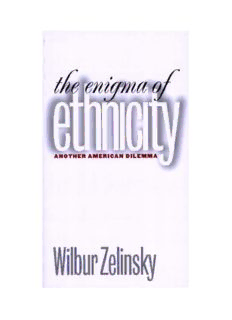
The Enigma of Ethnicity: Another American Dilemma PDF
Preview The Enigma of Ethnicity: Another American Dilemma
the enigma of ethnicity The enigma of ethnicity another american dilemma wilbur zelinsky university of iowa press iowa city University of Iowa Press, 01 02 03 04 05 c Iowa City 52242 5 4 3 2 1 Copyright © 2001 by the University of Iowa Press 01 02 03 04 05 p All rights reserved 5 4 3 2 1 Printed in the United States of America An earlier version of chapter 3, written Design by Richard Hendel incollaboration with Barrett A. Lee, http://www.uiowa.edu/~uipress appeared as “Heterolocalism: An No part of this book may be reproduced Alternative Model of the Sociospatial or used in any form or by any means Behaviour of Immigrant Ethnic without permission in writing from the Communities,” in the International publisher. All reasonable steps have been Journal of Population Geography4 taken to contact copyright holders of (1998): 1–18. A different version of material used in this book. The publisher chapter 4 appears under the title “The would be pleased to make suitable World and Its Identity Crisis,” in Karen arrangements with any whom it has Till, Steven Hoelscher, and Paul Adams, notbeen possible to reach. eds., Textures of Place(Minneapolis: University of Minnesota Press, The publication of this book was forthcoming, 2001). generously supported by the University of Iowa Foundation. Printed on acid-free paper Library of Congress Cataloging-in-Publication Data Zelinsky, Wilbur, 1921– The enigma of ethnicity: another American dilemma / by Wilbur Zelinsky. p. cm. Includes bibliographical references and index. isbn0-87745-749-2 (cloth)— isbn0-87745-750-6 (pbk.) 1. United States—Ethnic relations. 2. Ethnicity—United States. 3. Pluralism (Social sciences)—United States. I. Title. e184.a1 z45 2001 305.8(cid:1)00973—dc21 00-051157 For Gladys, now and forever contents Preface, ix 1 Coming to Terms, 1 2 Expressions, 54 3 Heterolocalism, 124 4 Thinking about Identity, 155 5 Explicating the Age of Ethnicity, 185 Notes, 231 References, 259 Index, 307 preface In recent years ethnic issues have commanded an inordinate amount of interest in both scholarly and public discourse in the United States and many other parts of the world. The result has been a vast outpouring of literature—more, it seems, than any single in- dividual could digest and master. It might also seem that the topic has been examined exhaustively, that we have run out of meaningful questions to ask, so that no real gaps remain in our understanding. As Abner Cohen has put it, “Ethnicity has already become the sub- ject of such an extensive literature that there can hardly be any con- ceptual formulation about it not made by someone before” (1981: 307). I do not concur. If I did, I would be committing an unpardon- able act of redundancy by offering in the extended essay that follows a product that would waste the knowledgeable reader’s time and mine. When, several years ago, I began this study—one that has proved to be a sequel of sorts to Nation into State(Zelinsky 1988a)— I was motivated only by a vague, generalized curiosity, the urge to educate myself about a subject that could not be ignored by a geog- rapher or anyone else intent upon grasping the realities of contem- porary America. But as I plowed through many hundreds of books and articles, consulted with colleagues, dipped into recollections of my earlier years, and peered at landscapes in a variety of places, the realization gradually grew that something crucial has been lacking in our hefty corpus of ethnic writings, or, rather, two closely related somethings. First, we have been afflicted with an unspoken consensus, a quite convenient one for certain analytical purposes, to the effect that eth- nicity is eternal and changeless, that this primordial quiddity has al- ways characterized virtually all complex societies. But the actuality, as Ihavelearnedtoperceiveit,andwillemphasizerelentlesslythrough-
Description: